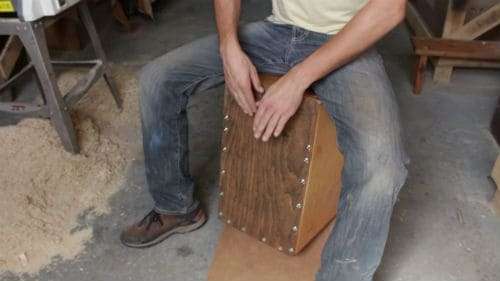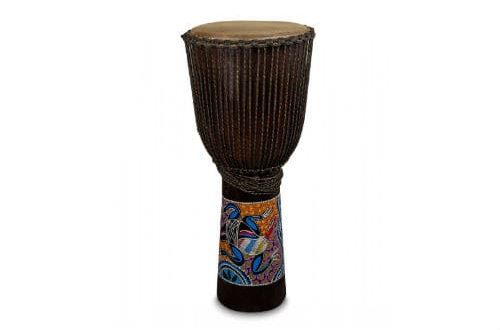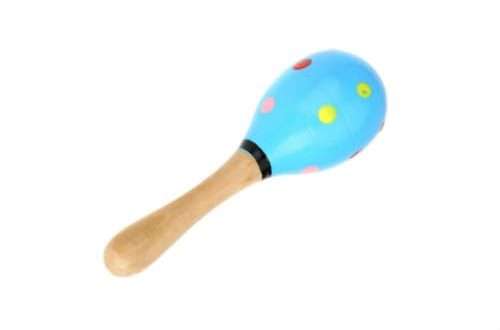
Cajon: what is it, instrument composition, sound, how to play, use
Contents
To become a musician, it is not necessary to have education and special skills. Some devices imply only that the performer has a great desire to participate in the process of creating interesting compositions. One of them is cajon. It can be played by anyone who has at least some sense of rhythm.
If you have no idea about the dynamic pattern and beats at all, you can use a musical instrument as … furniture, because it looks so much like a stool or an ordinary room bench.
How is the cajon
Outwardly, this is an ordinary plywood box with a hole in one of the planes. More than 200 years ago in Latin America, a wooden box was used as a percussion musical instrument. They simply sat on it and beat their hands on the side surfaces. A hole in one of the planes (phase inverter) reveals the sound. The front wall is tapa. It was made of glued or veneered plywood, bolted to the body.
Bolts perform not only a fastening function, but also an acoustic one. The stronger they were fixed, the quieter the sound. Weak fastening increased the sound power.

The cajon musical instrument belongs to the family of percussive string percussions. But the first copies were without strings, they looked like a primitive drum, completely hollow from the inside. Over time, varieties have appeared that expand the sound possibilities. The internal structure has acquired strings, the tension of which determines the sound.
Modern types of percussion boxes look more aesthetically pleasing. The sound range has expanded due to additional resonator holes and a phase inverter. The body is not made of wood, plywood with a thickness of 8-15 millimeters is more often used.
What does a cajon sound like?
For two centuries, people have learned to extract sounds of different timbres and pitches from an apparently primitive percussion instrument. They depend on the degree of tension of the stringer, pressing the strings to the tapa. Decorated and clear, three types of sounds are obtained, conventionally named:
- blow – a strong blow;
- bass – the performer outputs the main tone of the drum kit;
- sand is a fading blow.
The sound depends on the location and size of the phase inverter, the tension of the strings, pressing them to the tapa. To tune the instrument to a certain timbre, a string tensioner is used. Sound zones are distributed by installing a damper.
The cajon instrument is able to diversify ensemble melodies and sound solo. Like most percussions and drums, in an ensemble it highlights the rhythmic pattern, fills the composition with a certain tempo, brightness, and accentuates episodes.

History of origin
Cajon is a traditional Afro-Peruvian instrument. It is authentically known that it appeared during the period of Spanish colonization. Then the enslaved population was forbidden to show the features of the national culture. The population began to use boxes, tobacco boxes, cigar boxes instead of the usual tools. Whole fragments of wood were also used, in which the interior space was hollowed out.
The rooting of the Spaniards on the African continent gave the musical instrument its name. They began to call him “cajon” from the word cajon (box). Gradually, the new drum moved to Latin America, becoming traditional for slaves.
Peru is considered the birthplace of the cajon. It took only a few decades for the new instrument to gain popularity and become part of the cultural traditions of the Peruvian people. The main advantage is versatility, the ability to change the sound, timbre, create a variety of rhythmic patterns.
Cajon came to Europe in the 90th century, it gained immense popularity at the dawn of the 2001s. One of the popularizers of the box was the famous musician, virtuoso guitarist Paco de Lucia. It is the first traditional flamenco sounding Latin American traditional instrument. In XNUMX, the cajon officially became the National Heritage of Peru.

Types
For two centuries the wooden box has undergone changes. Today, there are several types of cajons, differing in sound, size, device:
- Without strings. The most primitive member of the family. Used in flamenco music. It has a limited range and timbre, a simple design in the form of an empty box with a resonator hole and tapa.
- String. It occurred to one of the musicians to fill the hollow box with guitar strings. They were placed in the corners next to the tapa. When struck, the strings resonated, the sound turned out to be richer, more saturated. Modern cajons use conventional drum stringers.
- Bass. He is a member of percussion ensembles. Has a larger size. It performs a rhythmic function along with other instruments of the percussive group.
Having become popular, the cajon is constantly undergoing changes in design, equipment with strings and additional accessories. Musicians improve it in such a way that the sound is more saturated. Ease of use is also important. So, there are T-shaped boxes, the leg of which is clamped between the legs of the musician. There are hexagonal and octagonal specimens with electronic “stuffing”, a different number of holes.

How to choose a cajon
Despite the instrument’s simplicity, the selection criteria are important for proper sound and ease of use. Pay attention to the material of the case. Plywood is cheaper than solid wood and is less susceptible to deformation. Modern fiberglass models sound louder, can work in large ensembles, have a bright, wide solo sound.
You should not save when choosing the material of tapas. Plastic and plywood don’t have the luscious range that wood surfaces do. The best option is ash, beech, maple, and other types of wood.
Professionals will approach the choice of tool even more scrupulously. They will need electronic equipment, microphones, other amplification systems that are used in concert activities. To choose a cajon, you must first of all rely on your own preferences, hearing, and the specifics of the Play. The strength of the structure, which must withstand the weight of the performer, is also important.
How to play the cajon
At the dawn of the drum, the position of the musician during the Play was determined. He is sitting, saddling the box and spreading his legs. The blows are carried out between the legs on the surface of the tapa. In this case, the sound hole is located on the side or behind. You can strike with the palm of your hand or with your fingertips. Special bones, sticks, nozzles are used. The sensitivity of the drum allows you to extract loud sounds even with light strokes.

Using
Most often, cajon is used in jazz, folk, ethno, latino. It is played by street musicians and members of professional groups, ensembles, orchestras. The main function of the drawer is to complement the main rhythm section. Therefore, the performer does not need to have the skills to play musical instruments, to know musical notation. It is enough to have a sense of rhythm.
A percussion box can replace a bass drum in a drum kit. This is a versatile instrument that can become an excellent accompaniment to piano and guitar works.





